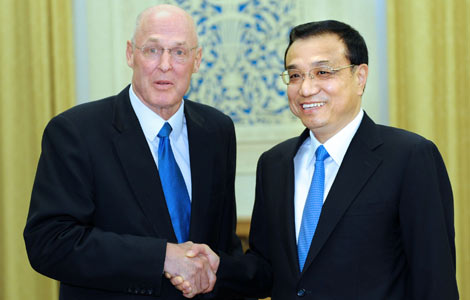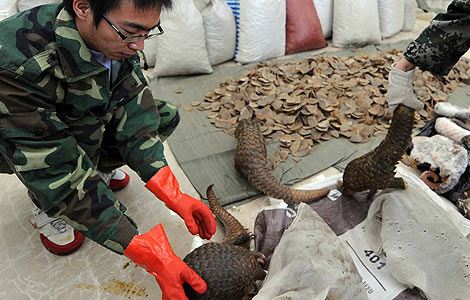China's WTO ride turns fears into fruit
Updated: 2011-12-09 22:18
(Xinhua)
|
|||||||||||
BEIJING - When China wrapped up 16 years of hard bargaining to secure long-awaited membership to the World Trade Organization (WTO) on December 11, 2001, Chinese firms were probably more alarmed than relieved.
With tariffs to be slashed and restrictions on foreign rivals to be eased, a shaky future seemed to loom for some of China's least competitive industries, notably banking, agriculture and auto making.
Ten years later, those industries are holding up well, if not thriving.
Chinese lenders are among the most profitable banks in the world and were barely hurt in the financial crisis. China's self-sufficiency rate in grains has remained above 95 percent, and the country surpassed the United States in 2009 to become the world's biggest auto producer.
Analysts attributed China's success to the catfish effect, government-sponsored reforms, limited market openness and its position in the global value chain.
The catfish effect, in which the existence of strong rivals drove the weak to improve themselves, was obvious in China's banking industry.
Back in 2001, having just survived the Asian financial crisis and freed of some of their massive bad loans with government aid, China's four major state-owned banks remained insolvent as a whole.
Today, those banks are much healthier than 10 years ago and passed the test of the global financial crisis with good asset quality and profitability, said Ba Shusong, an economist with the Development Research Center under the State Council, or China's Cabinet.
"Competition spurred China's banking industry to advance market-oriented reforms and improve its competitiveness through restructuring and better management ... so the key is whether the external pressure can change into an internal drive," Ba said.
In the past decade, the government helped rid the country's four major state-owned commercial banks of more non-performing loans. It also injected nearly $80 billion to help them restructure into shareholding companies.
And because China only agreed to limited openness for the financial services industry when joining the WTO, that provided a certain level of protection for the industry, analysts said.
"The government was being cautious with the financial sector," said Zhang Junsheng, a researcher with the Institute of International Economy, University of International Business and Economics. "It took into consideration how much the industry could bear."
Economist Louis Kuijs with the Hong Kong-based research group Fung Global Institute said China's WTO agreement made it hard for foreign companies to compete in several areas where they are restricted from entering the market or subject to differentiated prudential regulation.
Foreign banks accounted for only 1.85 percent of the total assets of all financial institutions in China at the end of 2010, according to central bank figures.
The combination of government-propelled reforms and limited openness also provided a cushion for China's agriculture, one of the most worrisome industries during WTO accession talks.
Tariffs on imported farm produce declined 72 percent in the past decade to less than a quarter of the world average, said agricultural economist Guo Xiaoming with the Sichuan Academy of Social Sciences.
Compared with highly mechanized and industrialized production in many developed countries, China's agriculture typically features small-scale, scattered production with less advanced technology.
As a result, China saw its trade deficit of farm produce surge. Some products such as soybeans, wool, rapeseed and cotton now heavily rely on the much cheaper, subsidized foreign supply.
Currently the self-sufficiency rates of soybeans, edible oil and cotton are 30 percent, 50 percent and 60 percent, Guo said.
"However, the impact on the overall agricultural sector was within the safe range," he said. "Overall, the sector is growing healthily and stably."
The government has remained basically self-sufficient in grain supply in the past decade, with grain output reporting the eighth consecutive year of growth.
China has reduced farmers' tax burdens, beefed up subsidies to grain growers and brought private capital into agricultural production to increase the scale and improve technology, Guo said.
Kuijs noted agriculture was not as open as manufacturing, a more competitive industry of China.
Trade restrictions remain in place in many agricultural markets, notable those of staple food, he said.
In China's manufacturing sector, one of its weakest links was the car industry, which had been protected by high tariffs and offered few choices for Chinese consumers before entry to the WTO.
High costs and weak brands and technology were among the biggest disadvantages of his company compared with foreign rivals, said Hu Maoyuan, chairman of the Shanghai Automotive Industry Corporation (Group) (SAIC Group), China's leading auto maker.
By July 2006, China had lowered the tariff on imported finished automobiles to 25 percent from 70-80 percent before WTO accession and that of imported parts and components down 10 percent from 18-65 percent.
Facing drastically tougher competition, SAIC Group managed to reduce its production costs 30 percent within the five-year grace period after WTO entry, while investing heavily to improve quality, technology and services, Hu said.
In 2010, SAIC Group ranked eighth in world auto sales, selling 3.58 million units.
Kuijs said China's policies to make foreign direct investment attractive led foreign car companies to build cars in China rather than import them.
As a result, China's market was not flooded by imported cars, but cars made by joint ventures of Chinese and foreign firms, saving Chinese car companies from being devastated by foreign brands, said auto analyst Jia Xinguang.
In 2010, the industrial output value of China's auto sector soared to almost 10 times the amount in 2001. The country's own car brands, notably Geely and Chery, also have taken off in the past decade.
Surging consumer demand, fueled by fast economic growth, helped Chinese car makers grow. China's per capita GDP exceeded $1,000 for the first time in 2001 and topped $4,000 in 2010.
At the initial stage of getting rich, people tend to choose cheaper cars, helping China's indigenous car brands gain market presence as foreign companies target higher-end markets, Jia said.
Like the car makers, many of China's manufacturing enterprises avoided direct competition with foreign firms because of their different positions in the industry, Zhang said.
As Chinese auto makers move up the value chain in the future and more foreign firms turn to the resilient Chinese market amid the economic downturn, competition is likely to intensify, Jia said.
Hot Topics
HIV/AIDS, Egypt protest, Thanksgiving, climate change, global economic recovery, home prices, high-speed railways, school bus safety, Libya situation, Weekly photos
Editor's Picks

|

|

|

|

|

|






